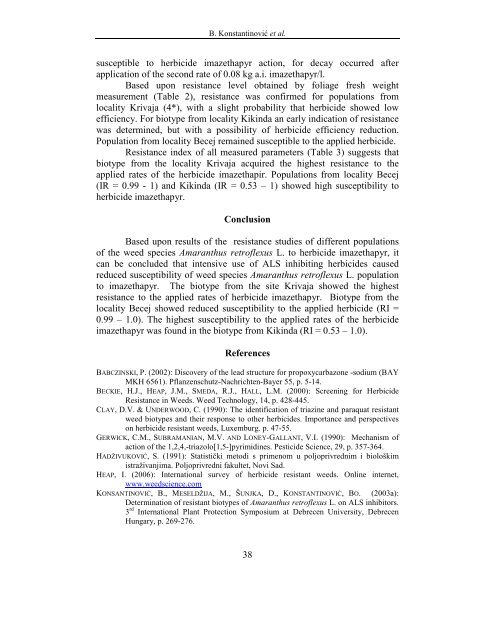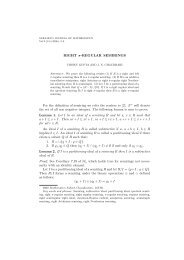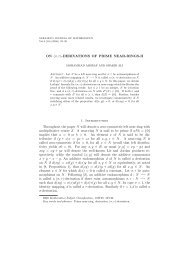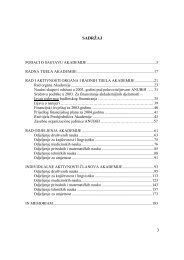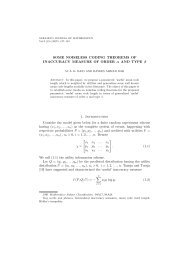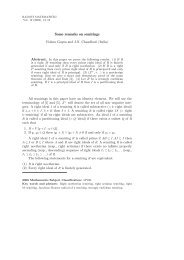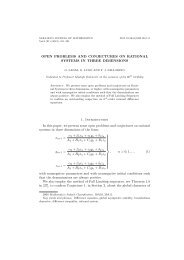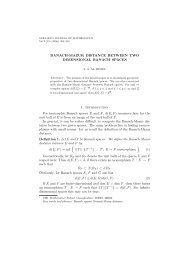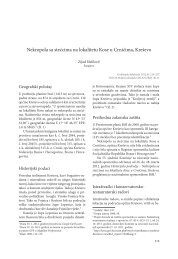HERBOLOGIA - anubih
HERBOLOGIA - anubih
HERBOLOGIA - anubih
Create successful ePaper yourself
Turn your PDF publications into a flip-book with our unique Google optimized e-Paper software.
B. Konstantinović et al.<br />
susceptible to herbicide imazethapyr action, for decay occurred after<br />
application of the second rate of 0.08 kg a.i. imazethapyr/l.<br />
Based upon resistance level obtained by foliage fresh weight<br />
measurement (Table 2), resistance was confirmed for populations from<br />
locality Krivaja (4*), with a slight probability that herbicide showed low<br />
efficiency. For biotype from locality Kikinda an early indication of resistance<br />
was determined, but with a possibility of herbicide efficiency reduction.<br />
Population from locality Becej remained susceptible to the applied herbicide.<br />
Resistance index of all measured parameters (Table 3) suggests that<br />
biotype from the locality Krivaja acquired the highest resistance to the<br />
applied rates of the herbicide imazethapir. Populations from locality Becej<br />
(IR = 0.99 - 1) and Kikinda (IR = 0.53 – 1) showed high susceptibility to<br />
herbicide imazethapyr.<br />
Conclusion<br />
Based upon results of the resistance studies of different populations<br />
of the weed species Amaranthus retroflexus L. to herbicide imazethapyr, it<br />
can be concluded that intensive use of ALS inhibiting herbicides caused<br />
reduced susceptibility of weed species Amaranthus retroflexus L. population<br />
to imazethapyr. The biotype from the site Krivaja showed the highest<br />
resistance to the applied rates of herbicide imazethapyr. Biotype from the<br />
locality Becej showed reduced susceptibility to the applied herbicide (RI =<br />
0.99 – 1.0). The highest susceptibility to the applied rates of the herbicide<br />
imazethapyr was found in the biotype from Kikinda (RI = 0.53 – 1.0).<br />
References<br />
BABCZINSKI, P. (2002): Discovery of the lead structure for propoxycarbazone -sodium (BAY<br />
MKH 6561). Pflanzenschutz-Nachrichten-Bayer 55, p. 5-14.<br />
BECKIE, H.J., HEAP, J.M., SMEDA, R.J., HALL, L.M. (2000): Screening for Herbicide<br />
Resistance in Weeds. Weed Technology, 14, p. 428-445.<br />
CLAY, D.V. & UNDERWOOD, C. (1990): The identification of triazine and paraquat resistant<br />
weed biotypes and their response to other herbicides. Importance and perspectives<br />
on herbicide resistant weeds, Luxemburg. p. 47-55.<br />
GERWICK, C.M., SUBRAMANIAN, M.V. AND LONEY-GALLANT, V.I. (1990): Mechanism of<br />
action of the 1,2,4,-triazolo[1,5-]pyrimidines. Pesticide Science, 29, p. 357-364.<br />
HADŽIVUKOVIĆ, S. (1991): Statistički metodi s primenom u poljoprivrednim i biološkim<br />
istraživanjima. Poljoprivredni fakultet, Novi Sad.<br />
HEAP, I. (2006): International survey of herbicide resistant weeds. Online internet,<br />
www.weedscience.com<br />
KONSANTINOVIĆ, B., MESELDŽIJA, M., ŠUNJKA, D., KONSTANTINOVIĆ, BO. (2003a):<br />
Determination of resistant biotypes of Amaranthus retroflexus L. on ALS inhibitors.<br />
3 rd International Plant Protection Symposium at Debrecen University, Debrecen<br />
Hungary, p. 269-276.<br />
38


